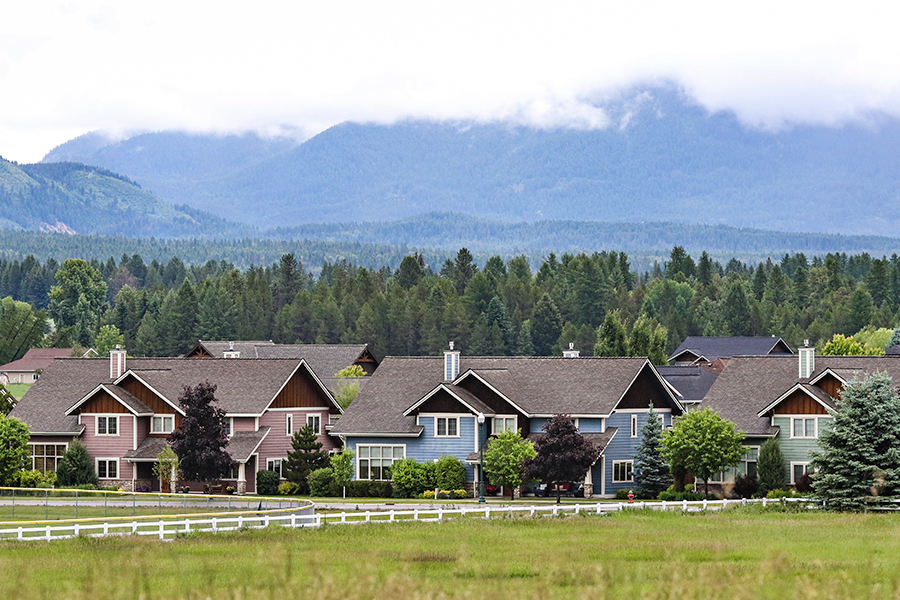New zoning rules set to take effect in Whitefish July 3 require that builders include affordable workforce housing in the majority of future housing developments.
According to the Whitefish Legacy Homes Program adopted a month ago by the Whitefish City Council, new residential developments that need a discretionary permit — such as a conditional use permit or a planned unit development — must include 20 percent of new housing units as permanently affordable through the Whitefish Housing Authority.
Called “inclusionary zoning,” the requirements are intended to assist working residents with moderate incomes. In Whitefish, a voluntary inclusionary zoning program has been on the books for years, but has produced very little housing.
Qualification for the program and pricing is on a sliding scale based on household income. As an example, Legacy Homes rental units will be priced to be affordable for two-person households earning a gross income of $33,420 to $44,560 per year, with a two-bedroom apartment renting from $941-$1,254. Two-person households earning $44,560 to $66,840 per year can qualify for ownership units, with two-bedroom homes priced from $175,603 to $263,404.
The new inclusionary zoning program is the latest in a series of regulatory steps Whitefish is taking to build out the local inventory of affordable housing, a scarcity of which has priced out some middle-income, working-class residents, leaving them with few options when it comes to finding cost-effective living arrangements.
The affordable housing problem has grown to such a degree that city officials have termed it a crisis, prompting them to implement the Whitefish Strategic Housing Plan and appoint a steering committee to craft a plan.
“This program is the right thing to do for our town,” Ben Davis, who chairs both the Strategic Housing Plan Steering Committee and the Whitefish Housing Authority boards, said. “We need to have this in place now because Whitefish is growing, and the housing challenges will only get worse.”
Responding to critics of the plan who say it has shortcomings, Whitefish City Councilor Katie Williams emphasized the ordinance has a contingency built into it requiring an annual review by council, as well as a report by city staff.
“If at anytime we start to see a series of red flags, we have the ability to call that review earlier if needed,” Williams said. “We are going to keep an eye on this and make sure that we don’t let it flounder too far.”
According to a workforce housing needs assessment released in December 2016, middle-income residents have limited options when it comes to finding housing, a problem that is displacing locals and forcing them to live outside their chosen community — 56 percent of Whitefish’s workforce lives in neighboring communities, 34 percent of whom would prefer to live in Whitefish.
The assessment identified a need for 980 total housing units to accommodate employee households through 2020, or 580 rentals and 400 ownership units. The assessment noted that only 70 percent of Whitefish homes are occupied by locals, which marks a 10 percent decline from 2000.
Senior Planner Wendy Compton-Ring said data reveals the average home sold in the Whitefish zip code in 2018 cost more than $600,000. The average mean income that can afford a house at that price is a household making more than $150,000.
“That is 291 percent of the Whitefish Area Median Income (AMI),” according to Compton-Ring.
The median cost for a house in 2018 was $475,000, which again is well over the area median income for Whitefish.
The AMI in Whitefish for a two-person household, which is the average household size in Whitefish, is a little over $55,000,” she said. “That household would be able to afford a $219,000 home, of which there are not very many in Whitefish.”
For developers to comply with the program, they will have to put together a Housing Mitigation Plan outlining how they will meet the requirements with every submittal.
The requirements stipulate that Legacy Homes should be built on-site and be architecturally similar to the rest of the development, using the same exterior materials and finishes. There are options in special cases for off-site development or paying cash in lieu of building units.
To help offset costs to the developer, the city is offering incentives such as reduced parking and increased density and building height for projects required to comply.
Residential projects that will be exempt from the mandatory affordable housing requirements include residential units that only require a building permit under the zoning code, minor subdivisions that qualify for a waiver of preliminary plat, one-lot subdivisions, and the construction of accessory apartments.
Since 2016, Whitefish has approved 340 lots, or 85 percent of the 400 lots that the housing needs assessment identified. Only 53 of those have been built, according to Compton-Ring. Of the 340 lots, 58 were proposed to be deed restricted and none of those have been built yet, while 253 condos were approved within that time frame as well.
Acknowledging the new program’s imperfections, Councilor Andy Feury said the city should take action because it cannot afford to move forward with no plan in place.
“Since 2016 we have lost 160 units roughly, by not having something in place,” Feury said. “We can drag our feet and we can wait, and we can lose another hundred units, and, in the meantime, we are starting to lose our community.”
“Everybody says we like affordable housing, but no one wants density next door,” Feury added. “That is the sacrifice that maybe all of us in the community need to make at some point and realize that.”
